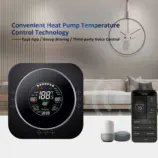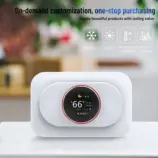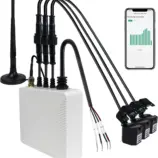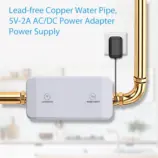Förstå vattenläckor och tidig upptäckt
Vattenläckor i ett hem kan vara allt från ett mindre irritationsmoment till en betydande katastrof. Om de inte upptäcks eller åtgärdas kan de leda till kostsamma reparationer, slöseri med resurser och omfattande skador på en fastighet. Tidig upptäckt och snabba åtgärder är avgörande för att förhindra de negativa effekterna av vattenläckor. Det här avsnittet av vår blogg kommer att utforska de vanligaste orsakerna till vattenläckor, hur man upptäcker dem tidigt och de första stegen som husägare kan vidta för att mildra skadorna.
Vanliga orsaker till vattenläckor
- Åldrande infrastruktur: Rör och VVS-system försämras med tiden, vilket gör äldre hus mer mottagliga för läckor.
- Högt vattentryck: För högt tryck kan stressa rör och fixturer, vilket leder till fel och läckor.
- Temperaturfluktuationer: Extrema temperaturförändringar kan få rören att expandera och dra ihop sig, vilket kan leda till sprickor och läckor.
- Korrosion: Kemiska reaktioner med vattenförsörjningen eller miljön kan korrodera rör, försvaga dem och orsaka läckor.
- Felaktiga apparater och inventarier: Tvättmaskiner, diskmaskiner och toaletter kan utveckla läckor på grund av slitage eller felaktig installation.
Tekniker för tidig upptäckt
Att upptäcka vattenläckor tidigt kan spara husägare tid, pengar och förhindra potentiella katastrofer. Här är några metoder för att snabbt identifiera läckor:
- Visuella inspektioner: Kontrollera regelbundet under handfat, runt toaletter och apparater för tecken på fukt- eller vattenskador.
- Övervaka vattenräkningar: En oförklarlig ökning av vattenanvändningen kan tyda på en läcka.
- Använd färgtester: För toaletter kan tillsats av färgämne i tanken avslöja läckor om färgämnet dyker upp i skålen utan att spola.
- Lyssna efter rinnande vatten: Ljud av rinnande vatten när alla kranar är avstängda kan tyda på en dold läcka.
- Fuktdetektorer: Att installera fuktsensorer i utsatta områden kan varna husägare för läckor.
Omedelbara åtgärder för att mildra skador
Vid upptäckt av en läcka kan omedelbara åtgärder förhindra ytterligare skador:
- Stäng av vattnet: Lokalisera och stäng av huvudvattentillförseln för att stoppa vattenflödet.
- Töm rören: Slå på kranarna för att tömma kvarvarande vatten i rören, vilket minskar risken för ytterligare läckage.
- Dokumentera skadan: Ta foton och anteckningar av skadan i försäkringssyfte.
- Kontakta ett proffs: För betydande läckor är det viktigt att kontakta en rörmokare eller en läcksökningsspecialist för att ta itu med problemet på rätt sätt.
Tidig upptäckt av vattenläckor är avgörande för att skydda ditt hem från omfattande skador och kostsamma reparationer. Genom att förstå de vanliga orsakerna, använda detektionstekniker och vidta snabba åtgärder kan husägare effektivt minska riskerna förknippade med vattenläckor. I följande avsnitt kommer vi att fördjupa oss i förebyggande strategier och hur smart hemteknik kan utnyttjas för att hantera och förhindra vattenläckor.
Förebyggande strategier för att förhindra vattenläckor
Det här avsnittet bygger på förståelsen för vattenläckor och deras tidiga upptäckt och fokuserar på effektiva strategier för att förhindra att läckor uppstår i första hand. Förebyggande är nyckeln till att undvika olägenheter, kostnader och skador i samband med vattenläckor. Att implementera följande strategier kan hjälpa till att upprätthålla ett läckagefritt hem.
Rutinunderhåll och inspektioner
- Regelbundna VVS-inspektioner: Schemalägg årliga inspektioner med en certifierad rörmokare för att kontrollera slitage, korrosion och andra potentiella problem i ditt VVS-system.
- Underhåll av apparaten: Inspektera och underhåll regelbundet apparater som använder vatten, såsom tvättmaskiner, diskmaskiner och varmvattenberedare, enligt tillverkarens riktlinjer.
- Inspektera kranar och duschmunstycken: Kontrollera om det finns dropp eller läckor och byt ut slitna delar eller fixturer vid behov.
Uppgradering och byte av åldrande infrastruktur
- Byte av rör: Överväg att byta ut gamla eller korroderade rör, särskilt om ditt hem är över 50 år gammalt. Moderna material som PVC eller PEX är mer motståndskraftiga mot korrosion och kan vara mer hållbara än gamla metallrör.
- Installera vattenbesparande armaturer: Toaletter, kranar och duschmunstycken med lågt flöde kan minska vattentrycksbelastningen på ditt VVS-system och minska risken för läckage.
Att ta itu med externa faktorer
- Isolera rören ordentligt: För att förhindra frysning och efterföljande sprängning i kallt klimat, isolera dina rör. Detta är särskilt viktigt i ouppvärmda områden i ditt hem, såsom källare, vindar och garage.
- Upprätthåll rätt vattentryck: Använd en tryckregulator för att säkerställa att ditt hems vattentryck ligger inom ett säkert intervall, vanligtvis mellan 40-70 psi, för att undvika onödig stress på ditt VVS-system.
Landskapsarkitektur och utomhusöverväganden
- Direkt vatten bort från hemmet: Se till att ditt hems landskap lutar bort från grunden för att förhindra vattenansamling som kan sippra in i källaren.
- Underhåll av rännor: Rengör och underhåll hängrännor och stuprör för att säkerställa korrekt dränering bort från ditt hem, vilket minskar risken för grundläckage.
Smart vattenhantering
Integrering av smart hemteknik kan erbjuda ett extra lager av skydd mot vattenläckor:
- Smarta vattensensorer: Installera sensorer i områden som är utsatta för vattenläckor, såsom badrum, kök och tvättstugor. Dessa enheter kan varna dig om närvaron av vatten, vilket möjliggör snabba åtgärder.
- Automatiserade vattenavstängningssystem: Överväg att installera ett system som automatiskt stänger av ditt hems vattentillförsel när en läcka upptäcks, vilket minimerar potentiella skador.
Att förhindra vattenläckor kräver en kombination av rutinunderhåll, uppgraderingar i rätt tid och proaktiva åtgärder för att hantera både interna och externa riskfaktorer. Genom att följa dessa strategier kan husägare avsevärt minska sannolikheten för läckor och skydda sina hem från potentiella vattenskador. I nästa avsnitt kommer vi att utforska hur man genom att utnyttja smart hemteknik ytterligare kan förbättra din förmåga att upptäcka och förhindra vattenläckor, vilket ger sinnesro och skyddar ditt hem mot vattenrelaterade problem.
Utnyttja Smart Home-teknik för upptäckt och förebyggande av vattenläckage
I de smarta hemmens tidevarv spelar tekniken en avgörande roll för att förbättra vår förmåga att upptäcka och förhindra vattenläckor, vilket ger husägare oöverträffad kontroll och sinnesro. I det här avsnittet utforskar vi den senaste tekniken för smarta hem som är utformad för hantering av vattenläckage och hur de kan integreras i ditt hem för att effektivt skydda mot vattenskador.
Framväxten av smart hemteknik inom läcksökning
Tekniken för smarta hem har revolutionerat många aspekter av hemhantering, och upptäckt och förebyggande av vattenläckage är inget undantag. Dessa intelligenta system och enheter ger övervakning i realtid, omedelbara varningar och till och med automatiskt ingripande för att minimera effekterna av vattenläckor.
Viktiga smarta hemenheter för läckagehantering
- Smarta vattensensorer: Dessa kompakta enheter kan placeras i områden där det är troligt att läckor uppstår, till exempel under handfat, nära varmvattenberedare eller runt toaletter. De upptäcker närvaron av vatten och skickar omedelbara varningar till din smartphone, vilket möjliggör snabba åtgärder.
- Smarta vattenavstängningsventiler: Dessa enheter är installerade på din huvudvattenledning och kan automatiskt stänga av vattnet till hela ditt hem när en läcka upptäcks av en ansluten sensor. Vissa modeller har fjärrkontroll, så att du kan hantera ditt hems vattenförsörjning var som helst.
- Smarta system för upptäckt av läckage: Mer omfattande lösningar integrerar flera sensorer och avstängningsfunktioner, vilket ger skydd i hela hemmet. Dessa system levereras ofta med smartphone-appar för övervakning och kontroll, som ger insikter om vattenanvändningsmönster och potentiella läckageplatser.
Fördelar med att integrera smart teknik för läcksökning
- Omedelbar upptäckt och varningar: Få varningar i samma ögonblick som en läcka upptäcks, vilket avsevärt minskar risken för omfattande vattenskador.
- Fjärrövervakning och kontroll: Hantera ditt hems vattensystem var som helst, så att du kan känna dig trygg när du är borta.
- Vattenvård: Smarta system kan hjälpa till att identifiera ineffektivitet i din vattenanvändning, främja bevarande och hjälpa till att minska elräkningarna.
- Försäkringsförmåner: Många försäkringsbolag erbjuder rabatter för hem som är utrustade med läckagedetekteringssystem, med tanke på den minskade risken för vattenskador.
Implementera smart läckagedetektering i ditt hem
Att integrera smart läckagedetektering i ditt hem innebär några viktiga steg:
- Bedöm dina behov: Tänk på storleken på ditt hem och de områden som löper störst risk för läckage för att avgöra hur många och vilka typer av enheter som behövs.
- Välj kompatibla enheter: Se till att alla enheter du köper är kompatibla med ditt hems befintliga smarta hemsystem eller smartphone.
- Professionell installation: Medan vissa enheter är designade för gör-det-själv-installation, överväg professionell installation för omfattande system för att säkerställa optimal prestanda.
- Regelbunden testning och underhåll: Testa dina enheter regelbundet och håll dem uppdaterade för att säkerställa att de fortsätter att fungera korrekt.
Genom att anamma smart hemteknik kan husägare ta en proaktiv hållning mot vattenläckor. Kombinationen av tidig upptäckt, omedelbara varningar och automatisk vattenavstängning förhindrar inte bara skador utan sparar också vatten och sparar pengar. I takt med att vi går framåt kommer integreringen av dessa tekniker i våra hem att bli allt mer sömlös, vilket erbjuder ett smartare, säkrare och mer hållbart sätt att hantera vår mest värdefulla resurs: vatten.



